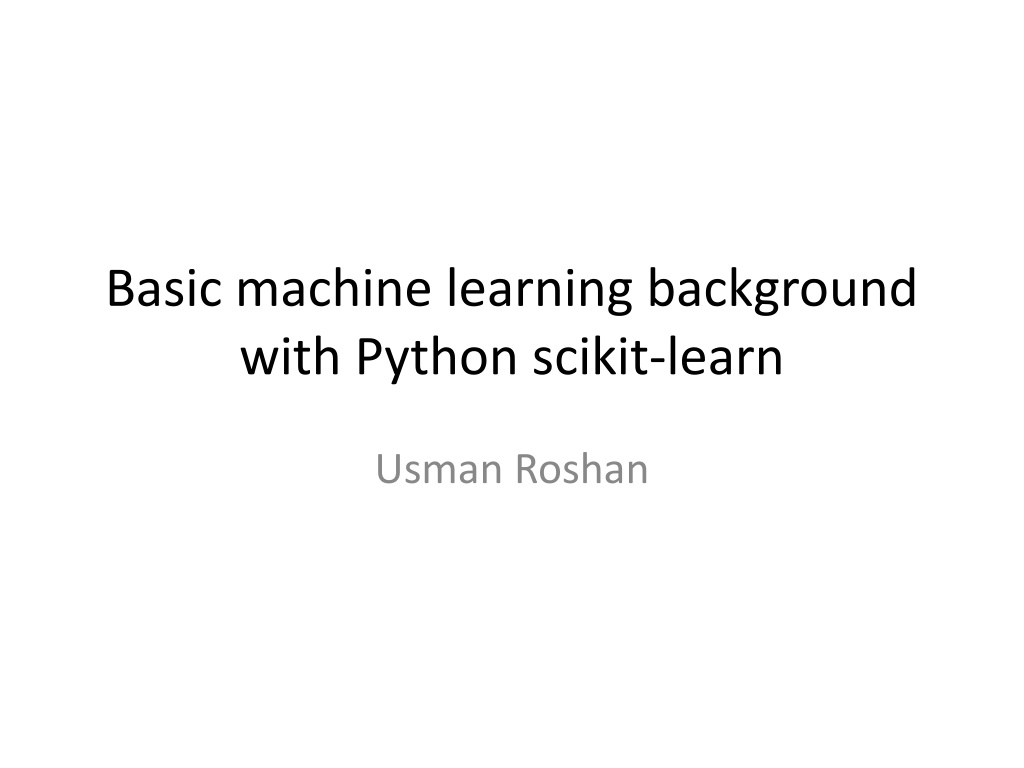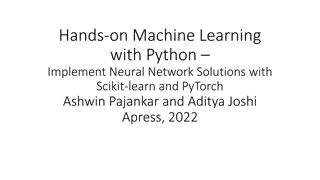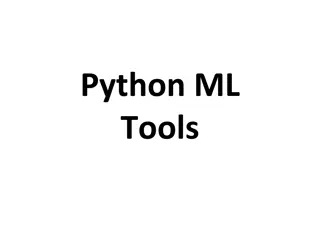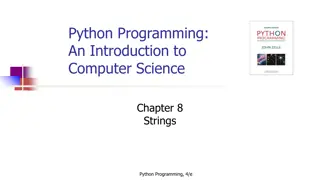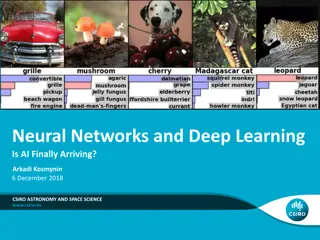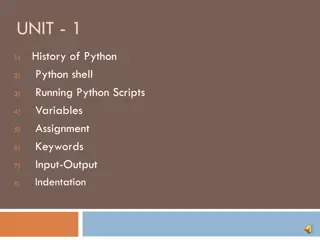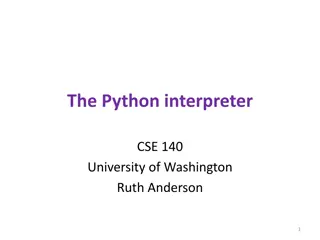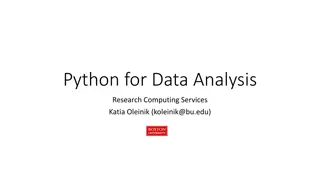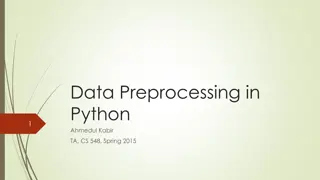Understanding Basic Machine Learning with Python using scikit-learn
Python is an object-oriented programming language essential for data science. Data science involves reasoning and decision-making from data, including machine learning, statistics, algorithms, and big data. The scikit-learn toolkit is a popular choice for machine learning tasks in Python, offering tools for classification, linear methods, non-linear methods, feature selection, clustering, and visualization with PCA.
Download Presentation

Please find below an Image/Link to download the presentation.
The content on the website is provided AS IS for your information and personal use only. It may not be sold, licensed, or shared on other websites without obtaining consent from the author. Download presentation by click this link. If you encounter any issues during the download, it is possible that the publisher has removed the file from their server.
E N D
Presentation Transcript
Basic machine learning background with Python scikit-learn Usman Roshan
Python An object oriented interpreter-based programming language Basic essentials Data types are numbers, strings, lists, and dictionaries (hash-tables) For loops and conditionals Functions Lists and hash-tables are references (like pointers in C) All variables are passed by value
Python Simple Python programs
Data science Data science Simple definition: reasoning and making decisions from data Contains machine learning, statistics, algorithms, programming, big data Basic machine learning problems Classification Linear methods Non-linear Feature selection Clustering (unsupervised learning) Visualization with PCA
Python scikit-learn Popular machine learning toolkit in Python http://scikit-learn.org/stable/ Requirements Anaconda Available from https://www.continuum.io/downloads Includes numpy, scipy, and scikit-learn (former two are necessary for scikit-learn)
Data We think of data as vectors in a fixed dimensional space For example
Classification Widely used task: given data determine the class it belongs to. The class will lead to a decision or outcome. Used in many different places: DNA and protein sequence classification Insurance Weather Experimental physics: Higgs Boson determination
Linear models We think of a linear model as a hyperplane in space The margin is the minimum distance of all closest point (misclassified have negative distance) The support vector machine is the hyperplane with largest margin y x
Support vector machine: optimally separating hyperplane In practice we allow for error terms in case there is no hyperplane. 1 2 i 2+C xi minw,w0,xi w s.t. yi(wTx+ w0) 1-xi xi 0
Optimally separating hyperplane with errors y w x
SVM on simple data Run SVM on example data shown earlier Solid line is SVM and dashed indicates margin
SVM in scikit-learn Dataset are taken from the UCI machine learning repository Learn an SVM model on training data Which parameter settings? C: tradeoff between error and model complexity (margin) max_iter: depth of the gradient descent algorithm Predict on test data
SVM in scikit-learn Analysis of SVM program on breast cancer data
Non-linear classification In practice some datasets may not be classifiable. Remember this may not be a big deal because the test error is more important than the train one
Non-linear classification Neural networks Create a new representation of the data where it is linearly separable Large networks leads to deep learning Decision trees Use several linear hyperplanes arranged in a tree Ensembles of decision trees are state of the art such as random forest and boosting
Decision tree From Alpaydin, 2010
Combining classifiers by bagging A single decision tree can overfit the data and have poor generalization (high error on test data). We can relieve this by bagging Bagging Randomly sample training data by bootstrapping Determine classifier Ci on sampled data Goto step 1 and repeat m times For final classifier output the majority vote Similar to tree bagging Compute decision trees on bootstrapped datasets Return majority vote
Variance reduction by voting What is the variance of the output of k classifiers? Thus we want classifiers to be independent to minimize variance Given independent binary classifiers each with accuracy > the majority vote accuracy increases as we increase the number of classifiers (Hansen and Salamon, IEEE Transactions of Pattern Analysis and Machine Intelligence, 1990)
Random forest In addition to sampling datapoints (feature vectors) we also sample features (to increase independence among classifiers) Compute many decision trees and output majority vote Can also rank features Alternative to bagging is to select datapoints with different probabilities that change in the algorithm (called boosting)
Decision tree and random forest in scikit-learn Learn a decision tree and random forest on training data Which parameter settings? Decision tree: Depth of tree Random forest: Number of trees Percentage of columns Predict on test data
Decision tree and random forest in scikit-learn
Data projection What is the mean and variance here? 3 2 1 1 2 3 4
Data projection Which line maximizes variance? 3 2 1 1 2 3 4
Data projection Which line maximizes variance? 3 2 1 1 2 3 4
Principal component analysis Find vector w of length 1 that maximizes variance of projected data
PCA optimization problem n 1 n (wTxi- wTm)2 subject to wTw =1 argmax w The optimization criterion can be rewritten as 1 n i=1 1 n i=1 1 n i=1 1 n i=1 wT1 n i=1 argmax w i=1 n (wT(xi- m))2= argmax w n (wT(xi- m))T(wT(xi- m)) = argmax w n ((xi- m)Tw)(wT(xi- m)) = argmax w n wT(xi- m)(xi- m)Tw = argmax w n (xi- m)(xi- m)Tw = argmax w wT w subject to wTw =1
Dimensionality reduction and visualization with PCA PCA plot of breast cancer data (output of program in previous slide)
Unsupervised learning - clustering K-means: popular fast program for clustering data Objective: find k clusters that minimize Euclidean distance of points in each cluster to their centers (means) i=1 2 || xj-mi||2 xj Ci
K-means algorithm for two clusters xi Rd,i =1 n Input: Algorithm: 1. Initialize: assign xi to C1 or C2 with equal probability and compute means: m1=1 C1 xi C1 1 m2= xi xi C2 xi C2 2. Recompute clusters: assign xi to C1 if ||xi-m1||<||xi-m2||, otherwise assign to C2 Recompute means m1 and m2 Compute objective i=1 3. 4. 2 || xj-mi||2 xj Ci d 5. Compute objective of new clustering. If difference is smaller than then stop, otherwise go to step 2.
K-means PCA plot in scikit-learn PCA plot of breast cancer data colored by true labels PCA plot of breast cancer data colored by k-means labels
Conclusion We saw basic data science and machine learning tasks in Python scikit-learn Can we handle very large datasets in Python scikit-learn? Yes For space use array from numpy to use a byte for a char and 4 for float and int. Otherwise more space is used because Python is object oriented For speed use stochastic gradient descent in scikit- learn (doesn t come with mini-batch though) and mini-batch k-means Deep learning stuff: Keras
